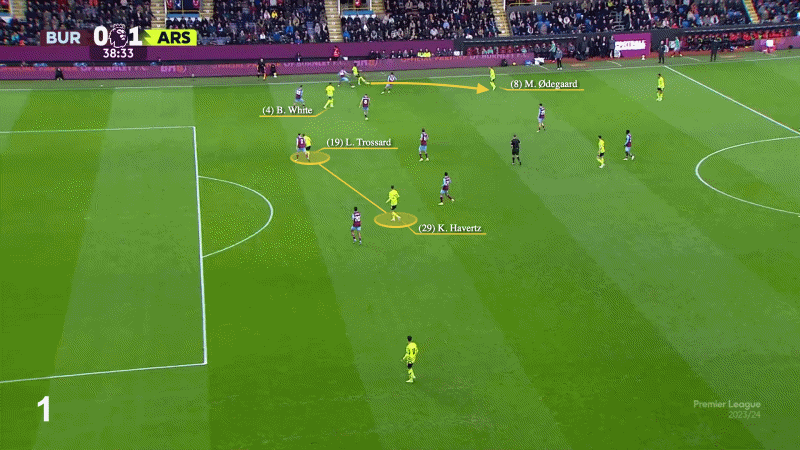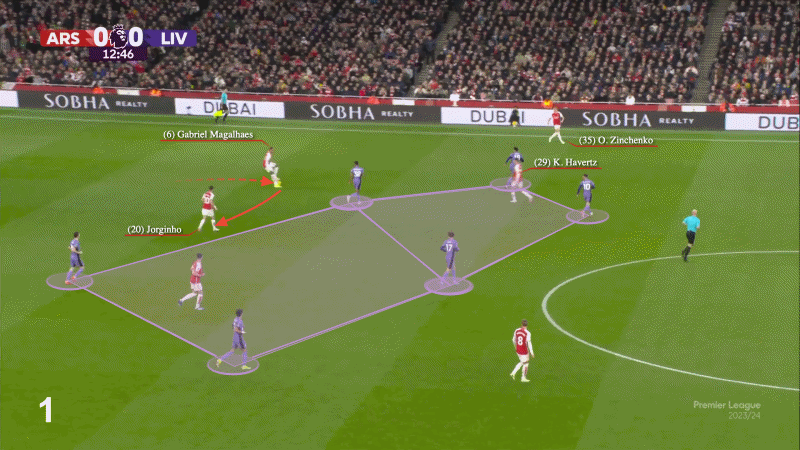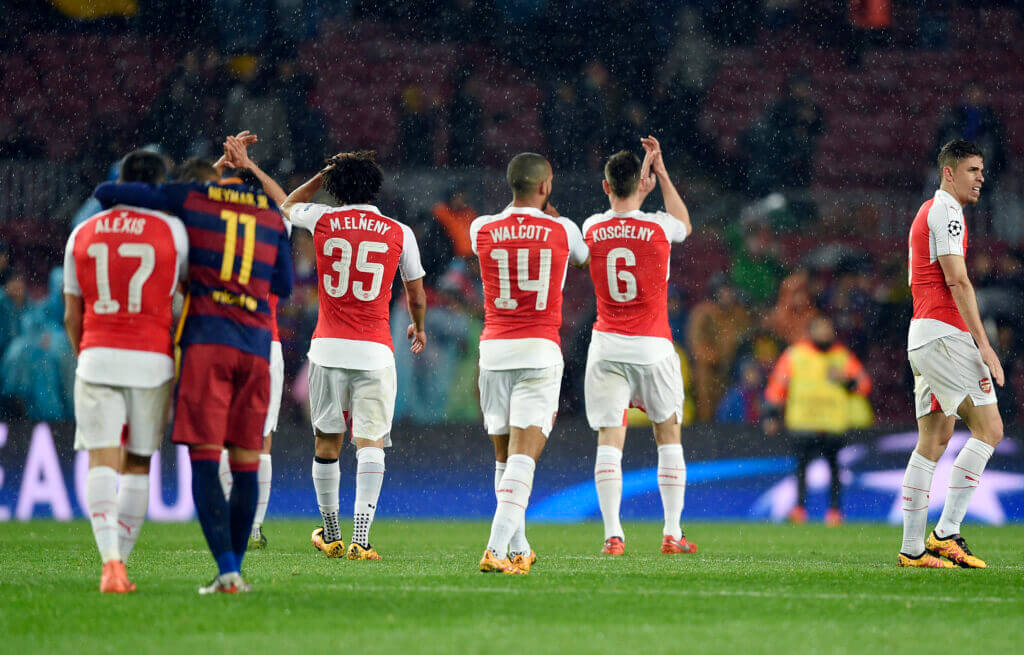The post-Christmas and New Year period was frustrating for Arsenal. They wasted early control against all of West Ham United, Fulham and Liverpool and lost those three games in a row, two of them at home, while scoring only one goal. They have played five, won five and scored 21 times since, looking much closer to the free-flowing Arsenal side who fought for the Premier League title last season.
Advertisement
People will naturally look to their warm-weather training trip to Dubai during the two-week gap between that 2-0 FA Cup loss to Liverpool and the 5-0 trouncing of Crystal Palace on January 20 as the spark for their new lease of life, and there certainly were benefits. The time away allowed players and staff alike to reset mentally and physically. It was also a chance to work on smaller details they do not usually have the time to focus on in a week such as this one, when training has to be squeezed in between multiple recovery sessions and travel days, plus another midweek game as the Champions League resumes.
The source of frustration for Arsenal before that Dubai break came down to execution. They peppered West Ham and Liverpool without scoring in those home defeats, and failed to hold onto an early lead at Fulham. Their expected goals (xG) total for that trio of games was 6.02, while their expected goals against (xGA) total was 3.31.
“What we have merited, we need to actually achieve it,” manager Mikel Arteta said when asked what needed to improve in January. “We need efficiency in both boxes to achieve that, because the rest is there. We have to make a step to achieve that.”
Aside from preventable errors, Arsenal have been largely efficient in their own penalty area this season. That step seems to have come in the opposition’s one — and a few factors have helped it along.
Two constant themes of their play over the past three seasons have helped, specifically the role of Bukayo Saka and their strength from attacking set pieces.
Saka has reached double figures for goals in each of the three Premier League campaigns and, with a current total of 12 in 24 games, he is on course for the best scoring season of his career (beating his 14 in 2021-22). He has scored six of Arsenal’s last 16 goals. Those six goals, all in the past four Premier League games, are as many as he had managed in 20 appearances in the division all season before this quartet of fixtures.
Advertisement
Overall, Arsenal have also scored more goals from set pieces, excluding penalties, than any club in the league (48) since Nicolas Jover’s appointment as set-piece coach in the summer of 2021, and are second behind Manchester City’s 67 when penalties are included (64). Of their past 21 goals, six have come from non-penalty set pieces.
But Saka hitting top form and that efficiency at set pieces are not the only factors behind this free-scoring run.
Eleven of those 21 goals Arsenal have scored since returning from Dubai have come in their past two games.
This is where Leandro Trossard and Kai Havertz dovetailing has added a different dimension to the front line.
The Athletic explored the possibility of using Trossard as a centre-forward following that win over Palace a month ago. The Belgium international played there last spring when Gabriel Jesus and Eddie Nketiah were injured, and Arsenal excelled. His tendency to roam allowed Granit Xhaka to push forward and Gabriel Martinelli to drift in from the left, allowing for quicker ball progression and more interplay around the opponents’ 18-yard box.
Those same patterns have emerged since Trossard was restored to that position for the games against West Ham and Burnley.
Against Burnley on Saturday, Havertz ran in behind to act as a target, with another forward running off him four times in the first half. One instance led to the chance below, which Trossard should have done better with.

Soon after, Havertz played another pass for an onrushing Trossard to win the penalty which Saka scored to make it 2-0.

Alongside their complementary movements, it helps having Martin Odegaard in such strong creative form, especially when they are willing and able to play forward.
Trossard often joined attacks against Burnley as the last man. In the West Ham match the previous weekend, his early involvement was more helpful as he dropped into midfield to receive the ball.
Advertisement
At first, this helped Odegaard find a forward pass through the lines. It then led to a more direct approach, with Martinelli and Saka as the main outlets.
Martinelli holds his width, which allows his other attacking team-mates to make supporting runs into the box.

The reverse happened after Arsenal took the lead through William Saliba.
Trossard receives unmarked on the turn in midfield again, looks up and quickly floats a ball over the top for Saka’s run in behind.
Saka then won and scored the penalty to make it 2-0.

This combination has come to light during Jesus’ latest absence, with a knee problem.
The Brazil international showed his quality in his most recent appearance, scoring and assisting in a 2-1 win against Nottingham Forest on January 30 and, of course, he should not be forgotten — especially with the return of Champions League football. But Arteta did speak about dealing with injuries last week, saying: “It’s a great opportunity to adapt players in certain positions, roles and spaces and see how they react. They are so willing, and sometimes that gives you a different solution that you didn’t think about. When you have players that are willing to change that, only good things happen.”
Although that Trossard-Havertz dynamic is new, some more consistent themes of Arsenal’s play have simply been executed better on this recent run.
PL 23-24 Arsenal ▲ | MD1-10 Total | MD1-10 Per Game | MD11-20 Total | MD11-20 Per Game | MD21-25 Total | MD21-25 Per Game |
|---|---|---|---|---|---|---|
Goals | 23 | 2.3 | 14 | 1.4 | 21 | 4.2 |
Goals conceded | 8 | 0.8 | 12 | 1.2 | 2 | 0.4 |
Shots | 144 | 14.4 | 181 | 18.1 | 96 | 19.2 |
Shots conceded | 84 | 8.4 | 88 | 8.8 | 44 | 8.8 |
xG | 19 | 1.9 | 18.2 | 1.82 | 13.9 | 2.78 |
xG conceded | 8 | 0.8 | 8.6 | 0.86 | 1.72 | 0.34 |
xG over/underperformance | 4 | -4.2 | 7.1 |
This phrase has been used often since the turn of the year, but the difference in Arsenal’s ‘ball speed’ has been vital. Arteta cited the lack of it after the 2-1 defeat at Fulham on New Year’s Eve and it has improved drastically since. Goalkeeper David Raya’s quick distribution has been part of this too, as he starts attacks that can either set the tone or change the momentum of games.
Also crucial is how Arsenal move the ball in their build-up. Recently, Ben White has been tucking in centrally from right-back while Oleksandr Zinchenko, who usually does that from the left, has been out of the team. Jakub Kiwior holding his position at left-back, and centre-back Saliba pulling wider behind him, then gives opposing teams a different picture to understand.
Advertisement
Improvements in Arsenal’s build-up were visible before Zinchenko’s injury lay-off began, and have been somewhat explained by the departed Xhaka.
Speaking to the Professional Footballers’ Association about the differences between Arteta and Xabi Alonso, his manager these days after a summer move to Germany’s Bayern Leverkusen, Xhaka said: “Mikel has his philosophy and that’s it: always change the sides, ‘I’m a free man’, ‘Let him jump’, for example. Even to always play with a back four, never a back five or a 4-4-2 with two proper strikers. You have this 4-3-3 with one No 6 and two No 8s.”
The talk about Arteta’s Arsenal never having two strikers would support the idea that the Trossard-Havertz dynamic was a ‘different solution’ the manager had not initially thought about, but the start of Xhaka’s above answer is more important.
Arsenal changing sides, looking for a free man and causing markers to ‘jump’ are all ingrained in their build-up. It becomes harder to force markers to jump and find a free man when your passing is one-paced. That changes when more speed is injected into that switching of sides, however. The opener in the league match against Liverpool earlier this month is the best example.
Most of the focus on that goal was around the positioning of Virgil van Dijk and Ibrahima Konate. Arsenal made 24 consecutive passes before Havertz’s shot was parried into goalscorer Saka’s path, though, so what led to that?
Arsenal started off patiently. They began on the left, which was crowded, so changed sides to the right. Both Curtis Jones and Diogo Jota jumped out to press, so they switched sides again and played several first-time passes to quickly bypass Liverpool’s pressure. Zinchenko, Odegaard and Havertz were all the ‘free men’ found in space, as seen below.

Here is a bird’s-eye view of that entire move:

This comes back to Arteta’s request from 2022 for ‘300,000 passes’. The emphasis was on gaining control of games and coaxing opposition players into certain areas of the pitch before exploiting the spaces they vacate with quick, incisive passes later in the move.
Arsenal developing new ways to attack teams is promising. It means there is less chance of them getting bogged down by being able to play only one way. Still, executing the plans that Arteta originally set them will be equally important as they look to maintain their recent levels of attacking verve.
The coming weeks will present Arteta with an opportunity to remind everyone what Jesus can do when he returns from injury.
Even so, more variation in attack could be vital as Arsenal seek to challenge in Europe and the Premier League.

GO DEEPER
Arsenal and the Champions League round of 16: A story in need of a different ending
(Photo: Marc Atkins/Getty Images)


